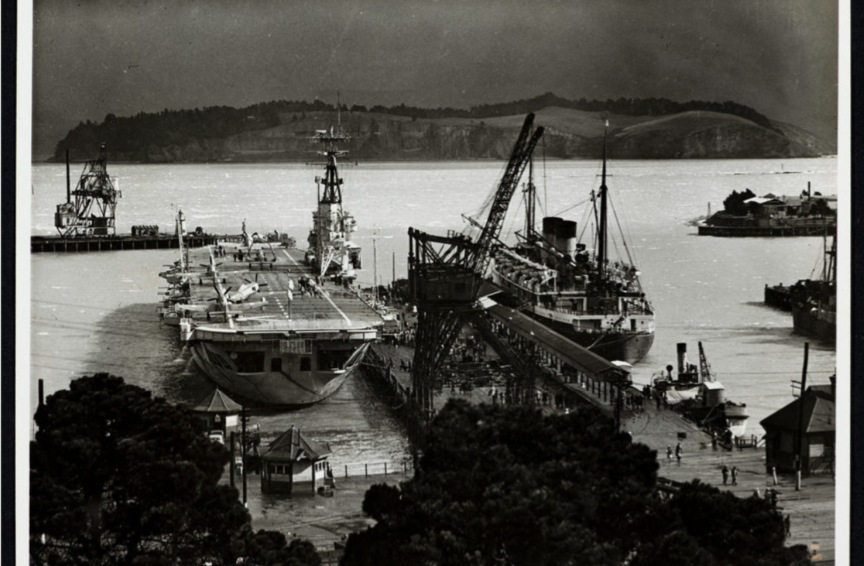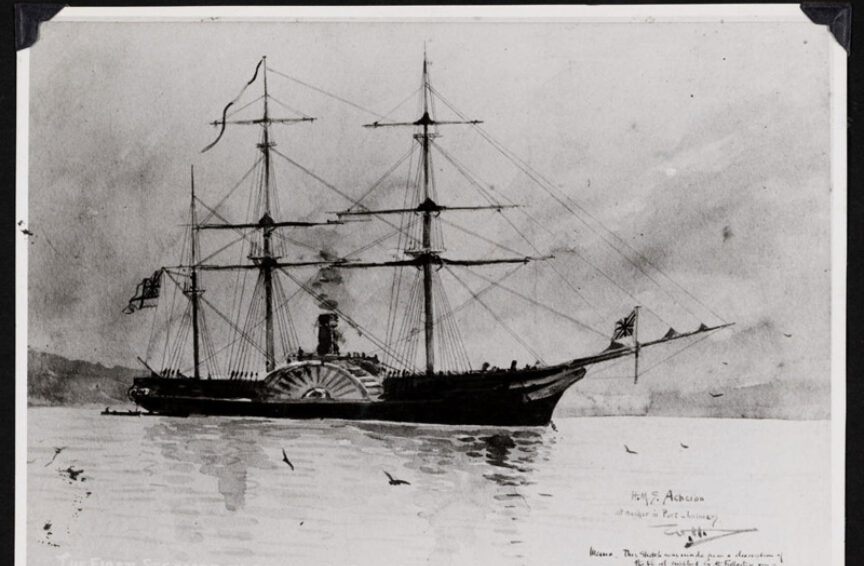PO Box 95
Lyttelton 8841
Te Ūaka recognises Te Hapū o Ngāti Wheke as Mana Whenua and Mana Moana for Te Whakaraupō / Lyttelton Harbour.
A Black Prince and Bellona in Whakaraupō
On the afternoon of 30 April 1946 the British Royal Navy’s light cruiser HMS Black Prince steamed quietly through the heads of Whakaraupō Lyttelton Harbour without the assistance of the harbour pilot or tug, on its way to berth at Lyttelton Port’s No. 4 Wharf. Greeted by a small crowd of sightseers, the ship’s crew were invited to festivities held by the Christchurch-based Union Jack Club Inc., while its officers were wined and dined by dignitaries from the Lyttelton Harbour Board and Borough Council. In the days that followed, the cruiser was open to the public and over 1500 people, many of them school children, went aboard to inspect what was soon to become the newest addition to the Royal New Zealand Navy (RNZN).
Having been formed from the Royal Navy’s New Zealand Division just five years earlier in October 1941, the RNZN’s wartime fleet had acquitted itself with honours in numerous WWII battles from the Atlantic to the Pacific oceans. In the immediate aftermath of WWII, however, the RNZN was looking to adapt to peacetime conditions which required modernising its ageing fleet and expanding its personnel. As part of this post-war transition, the old cruisers HMNZS Achilles and Gambia were replaced by two former Royal Navy ‘Improved’ Dido-class light cruisers, with the RNZN flagship HMNZS Bellona commissioned on 17 April 1946, followed by HMNZS Black Prince on 25 May 1946.
Launched in August 1942 and commissioned in November 1943, HMS Black Prince had a notable WWII service history in the Royal Navy, from operations in the North Sea to participation in the D-Day landings, as well as actions in the Mediterranean and the Pacific including the battle of Okinawa. Displacing 6050 tonnes, she was 156 m long with a 15.4 m beam and 4.3 m draught. Propelled by four Admiralty 3-drum boilers producing 62,000 shaft horsepower (46 megawatts) driving four geared steam turbines for a maximum speed of 32.25 knots (59.73 km/h), the Black Prince had a range of 6,824 km at 16 knots (30 km/h) cruising speed. With a full complement of 530 men and main armament of eight QF 5.25-inch guns in four dual turrets fore and aft, these Royal Navy Dido-class light cruisers were considered a fitting ‘hand-me-down’ for the young RNZN.
After its brief stay at Lyttelton the Black Prince departed on 5 May 1946 for commissioning and a full refit at its new Auckland station, where it was to be joined by its newly appointed Commander, Ashburton resident Captain Charles Clinton Stevens. Commander Stevens had been a longtime member of the Royal Naval Volunteer Reserve (New Zealand) while working at the Massey Harris Agency in Ashburton. On the outbreak of WWII he joined the minesweeper fleet before serving with distinction in the Mediterranean and Pacific theatres. His new appointment was to oversee the modernisation of the newly acquired HMNZS Black Prince. However, budget constraints and recruitment difficulties, followed by ‘mutinies’ amongst many RNZN crews related to pay and welfare concerns throughout 1947, would see the Black Prince mothballed until its refit was completed in 1952-3.
The Black Prince’s sister-ship HMNZS Bellona had also been commissioned into the Royal Navy in 1943, participating in various WWII operations including arctic convoys, the naval campaign against the famous Nazi battleship Tirpitz, as well as the Normandy landings. In April 1947 her RNZN crew was also involved in a ‘mutiny’ while in port at Auckland. The following November she visited Ōhinehou Lyttelton as part of a Te Waipounamu South Island tour. While the ship was in port, a large number of her crew were on leave in the central city when Ballantynes department store caught fire around 3:48 pm on the afternoon of 18 November 1947. The fierce intensity of the blaze attracted large crowds at which point the Bellona crew stepped in to assist the fire brigade and keep the public out of harm's way before police reinforcements arrived. This catastrophic fire killed 41 employees and remains the deadliest fire disaster in the country’s history.
Over the ensuing years HMNZS Bellona, with the Black Prince from 1952-55, would play key roles alongside the newly acquired Loch-class frigates, in training, regional cooperation, and maintaining Aotearoa New Zealand's post-war naval presence in the Pacific. Bellona was returned to the Royal Navy in 1956, controversially replaced by its ageing fellow Dido-class cruiser HMNZS Royalist. The old Black Prince represented the RNZN at the coronation of Queen Elizabeth II in 1953, and made one last port of call at Lyttelton on 18-19 January 1954 while escorting the Royal Yacht Gothic on Queen Elizabeth's NZ tour. She was decommissioned in August 1955 to serve out her days as an accommodation and spare parts ship before being towed to Japan for scrap in 1962.

